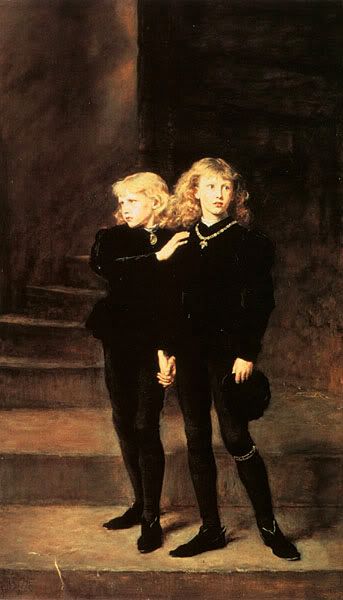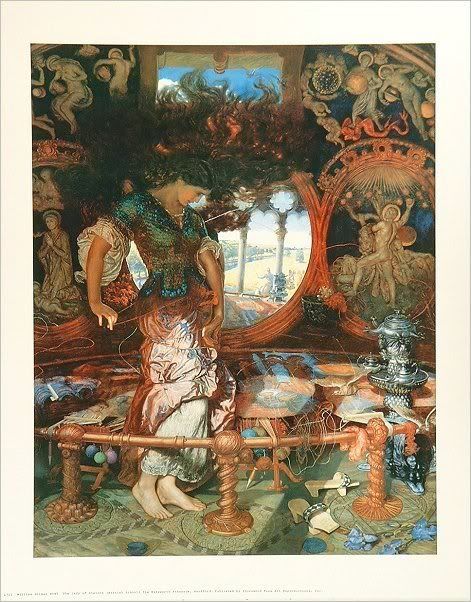
Brigham Young University Museum of Art is currently hosting an exhibit of Victorian-era artworks from the Royal Holloway collection entitled Paintings from the Reign of Victoria: The Royal Holloway Collection, London . Pre-Raphaelite John Everett Millais' 1878 painting The Two Princes Edward and Richard in the Tower, 1483 (shown above) is among the works on display.
The exhibition will run from August 14-October 24, 2009, and is a must see for anyone in the area. Admission to the exhibit is free of charge. You can even organize a free docent-led tour of the exhibit by calling the Museum Education Department at 801-422-1140. You can also check out Brigham Young University Museum of Art's sepcial Royal Holloway exhibit website for more background information on the event. (It's a great resource, especially if you aren't able to make it to the exhibit).
image courtesy Wikimedia commons.
Tuesday, August 25, 2009
Victorian Art on Display at Brigham Young University Museum of Art
Posted by
Margaret
at
8:34 AM
4
comments
![]()
![]()
Tuesday, August 18, 2009
William Morris and Islamic Art
Journalist Navid Akhtar has taken an opportunity to examine the influence that Islamic design had on William Morris.
Akhtar argues that Morris' designs are "inextricably linked to the curving sinuous arabesques of traditional Islamic Art," pointing out the strong connection between Morris' work and Turkish ceramics and Persian carpets.
Akhtar goes on to argue that Morris was influenced, not only by the aesthetics of Islamic art, but by the principles that guided that art. He even suggests that Morris' famous decorating maxim "have nothing in your house that you do not know to be useful, or believe to be beautiful,"--is drawn from a saying in the Koran that "God is beautiful and loves beauty".
While this might be a bit of a stretch, it's undeniable that Morris and many of his friends in the Pre-Raphaelite Brotherhood were strongly influenced by Islamic design elements (particularly the repetition and symmetry that can be found in many middle-eastern art). Akhter suggests that many of the notions that Morris held dear--such as the importance of social consciousness, usefulness and beauty in every day objects-- were also common to Islamic art.
I think it was very important to Morris that these ideals were universal, but it's also interesting to see that a new generation of Muslim artists using Morris as artistic inspiration. What are your thoughts?
You can listen to the full radio broadcast at the BBC.
Posted by
Margaret
at
8:49 AM
8
comments
![]()
![]()
Labels: architecture, arts and crafts, news, reviews, william morris
Monday, August 10, 2009
BBC 4 The Pre Raphaelites
For those of you living in the UK, the BBC has released a 3-part documentary series on the Pre-Raphaelites to coincide with Desperate Romantics. Since Desperate Romantics is rather short on historical context, be sure to watch the documentary alongside the costume drama, especially if this is your first introduction to the Pre-Raphaelites. 
The documentary, entitled The Pre-Raphaelites: Victorian Revolutionaries, features author Jan Marsh (author of Pre-Raphaelite Sisterhood) and a number of other art historians discussing the PRB's rise to fame, their landscape art and the eventual commercialisation of their work.
I really enjoyed the series, although I found it a little annoying that they kept insisting that the Pre Raphaelite Brotherhood somehow "sold out" when they began to find a market for their art. The series really pushes the notion that the Pre-Raphaelites were somehow the first artists to commercialise their work (and that this was a betrayal of their earlier, nobler ideals). Artists and writers have always wanted to profit from their work. It's pure romantic fantasy to imagine that there was some golden age of art where everyone indulged in art for art's sake without an eye toward profits. The PRB simply lucked out by being in the right place at the right time, and they took advantage of the technology that was available to them. I'm quite sure that if Sir Joshua Reynolds had lived through the Victorian era, he too would have been hawking his lithographs right alongside the former members of the PRB. You will remember that even the socialist William Morris was a businessman! It seems very hard for the BBC to conceive of the possibility that one might simultaneously be a romantic revolutionary and hope to pay the rent.
For those of you living in the UK, several of the episodes are available in streaming video online through the BBC Pre-Raphaelites mini site.
Episode 2, which covers the Pre-Raphaelites approach to landscape art, will be aired again on August 11 at 10:00 pm.
Posted by
Margaret
at
8:24 AM
7
comments
![]()
![]()
Labels: millais, news, pre-raphaelites, reviews, rossetti, william holman hunt, william morris
Monday, August 3, 2009
Desperate Romantics - First Impressions
I finally had a chance to watch the first two episodes of BBC's Desperate Romantics with Javier last week. We both really enjoyed it. Overall, I found it highly entertaining (and yes, it was quite accurately described by its producer as "Entourage with easels"). The production was a bit weak on the historical front, but I suppose this was done by the writers to broaden the appeal of the series.
The series focuses on the early years of the Pre-Raphaelite Brotherhood and follows their rise to fame.
I was pleasantly surprised with the casting, particularly that of Lizzie Siddal. The actress who plays Lizzie not only resembles Siddal a great deal, but she also does an excellent job of bringing life and pathos to the character. John and Effie Ruskin are also well-cast, and are more developed than I had anticipated, although the endless speculation about what was wrong with their marriage always gets to me--honestly, nobody has any idea what the problem was (biographers seem to constantly return to the idea that Ruskin was disgusted by Effie's body hair, but how could they know?). Nevertheless, much like the rumours about Michael Jackson, I suppose this gossip is just too juicy for scriptwriters to pass up.
Unfortunately, the characterization of most of the other major players is rather simplistic, though it is in keeping with the rest of the shows' approach. Aidan Turner is handsome and energetic as Dante Gabriel Rossetti, if a bit one-dimensional. William Holman Hunt's character certainly seems to have drawn the short straw in terms of personality. Most biographers of the Pre-Raphaelites tend to consider Hunt a bit of a blowhard, but he's painted with such a broad brush in this production that it borders on the ridiculous. I hope that the writers will add some nuance to his character in the remaining episodes. Perhaps the most promising character so far is that of John Everett Millais, who is played by Samuel Barnett. Millais' character is quite endearing, and it looks like we will be seeing more of him in tonight's episode.
The character I could sort of do without is Fred Walters--a fictional hanger-on that is meant to function as a bit of a window into the lives of the PRB. He's sort of an amalgamation of a number of real-life members of the brotherhood, but I really wish that they had included William Michael Rossetti in the story instead. William Michael has always seemed quite interesting to me, and he certainly did a great deal to contribute to the visibility of the Brotherhood. I suppose the writers felt that adding in another member of the Rossetti family would rob Dante Gabriel of some of his mystique, but I digress.
Overall, I'm definitely enjoying the series. It's so nice to finally see the lives of the Pre-Raphaelites dramatized! Desperate Romantics may fall a bit short on historical accuracy, but the story of the Pre-Raphaelite Brotherhood is so inherently exciting that the show can't help but be enormously entertaining.
I'd be extremely interested to hear from others who've had a chance to see the first few episodes. What were your first impressions? Were you pleased or disappointed? Do you think the show will revive interest in the Pre-Raphaelites?
Posted by
Margaret
at
11:31 AM
11
comments
![]()
![]()
Labels: millais, news, pre-raphaelites, reviews, rossetti, ruskin, william holman hunt

